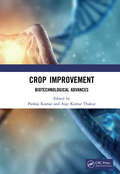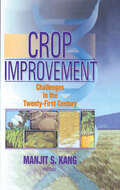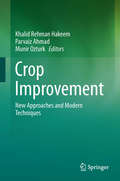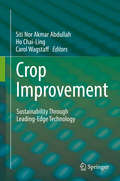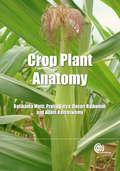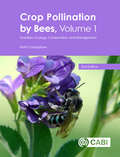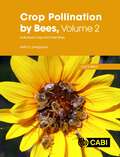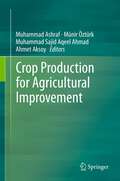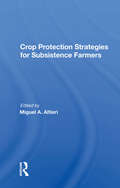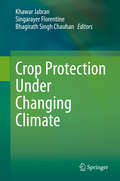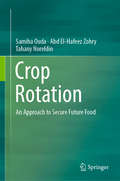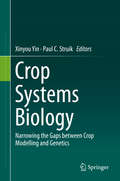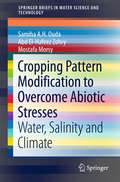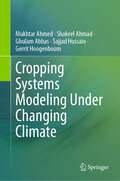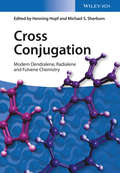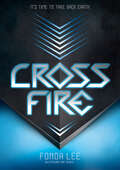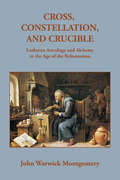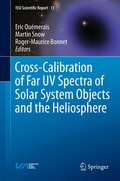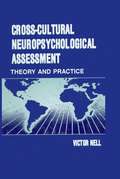- Table View
- List View
Crop Improvement: Biotechnological Advances
by Pankaj Kumar Thakur Ajay KumarCrop Improvement: Biotechnological Advances – Biomedical Science The field of biotechnology is advancing at a fast pace. The availability of low-cost DNA/genome sequencing technologies has led to the discovery and functional characterization of myriad of genes imparting stress tolerance and quality traits. The ‘omics’ group of technologies including genomics, proteomics, transcriptomics and metabolomics has revolutionized the agricultural biotechnology sector. The Nobel Prize-winning technology, such as the genome editing technique, is being employed to edit various gene functions in plants aiding in crop improvement. This technology may be adopted very quickly by consumers compared with the transgenic technique because the genome-edited plants have no adverse effects on the genome of the plant itself and on the environment and related species/non-target organisms. In this book, authors have attempted to compile the latest techniques of agricultural biotechnology and their applications in crop improvement. Certain chapters have been dedicated to describe the use of nanotechnology, a fast emerging new technique in the agriculture sector. Features Development, potential and safety issues in biotechnology Advances in genomics, proteomics and transcriptomics in agriculture Protein bioinformatics and its applications Genetically modified (GM) technology and its implications Genome editing in crop improvement Marker-assisted selection (MAS) in crop improvement Mutation breeding Cryobiotechnology Nanotechnology and biosensors This book includes real-world examples and applications making it accessible to a broader interdisciplinary readership. We hope that it will serve as a reference book for researchers engaged in molecular biology and biotechnology and will act as a ready reckoner for postgraduate (PG) students in the biotechnology discipline.
Crop Improvement: Challenges in the Twenty-First Century
by Manjit S. KangLearn to integrate molecular genetic techniques with traditional plant breeding methods!This comprehensive book provides the latest authoritative scientific information on improvement of both temperate and tropical crops. Crop Improvement: Challenges in the Twenty-First Century brings together expert plant breeders and geneticists to address issues related to crop adaptability and stability across environments for important food and fiber crops. It emphasizes the need to integrate molecular genetic techniques with traditional plant breeding methods to develop hardier, more productive crops. Crop Improvement includes the latest research on physiological and biochemical responses of plants to drought and heat stress, which should help breeders develop effective strategies for improving resistance to abiotic stresses. In addition, this helpful book elucidates the use of mixed models and best linear unbiased prediction. To make the book comprehensive, chapters discuss stability analysis in crop performance trials and genotype-by-environment interactions.Crop Improvement includes detailed information on breeding specific crops, including: rice tropical maize sorghum common bean sugar beet bananas and plantain cotton Crop Improvement offers both practical information and up-to-date research. It also suggests a vision of new directions and partnerships that are expected to evolve in this century. This book is an essential resource for practicing plant breeders and geneticists at universities, government agencies, and industry. It should also be of use to teachers and students engaged in crop breeding.
Crop Improvement: New Approaches and Modern Techniques
by Parvaiz Ahmad Khalid Rehman Hakeem Munir OzturkThe improvement of crop species has been a basic pursuit since cultivation began thousands of years ago. To feed an ever increasing world population will require a great increase in food production. Wheat, corn, rice, potato and few others are expected to lead as the most important crops in the world. Enormous efforts are made all over the world to document as well as use these resources. Everybody knows that the introgression of genes in wheat provided the foundation for the "Green Revolution". Later also demonstrated the great impact that genetic resources have on production. Several factors are contributing to high plant performance under different environmental conditions, therefore an effective and complementary use of all available technological tools and resources is needed to meet the challenge.
Crop Improvement: Sustainability Through Leading-Edge Technology
by Siti Nor Akmar Abdullah Ho Chai-Ling Carol WagstaffThe book covers the latest development in the biosciences field covering key topics in crop improvement including 'omic approaches to improving sustainable crop production, advancement in marker technology, strategies in genetic manipulation, crop quality and sustainability and plant microbe interaction detailing on proven technologies to address critical issue for agricultural sustainability which are beneficial for researchers and students. The book also includes aspects of preserving crops after harvest as this is a key factor in promoting sustainable crop quality in terms of addressing waste, choosing the appropriate packaging and moving crops through the food and industrial supply chain. An important strategy to overcome the challenges in providing food for the world population in a sustainable manner is through concerted efforts by crop scientists to embrace new technologies in increasing yield, quality and improving food safety while minimizing adverse environmental impact of the agricultural activities. Most of the proven molecular and genetic technologies in crop science have been tested and verified in model plants such as Arabidopsis and tomato. The technologies, when deployed on various plant species of importance for human nutrition and industrial applications, including cereals, vegetables, fruits, herbs, fibre and oil crops, face many challenges, not only due to their longer life cycle but many other physiological and environmental factors affecting yield and quality of plant products. Furthermore, major impacts on crop production due to catastrophic diseases and global climate change needs urgent and innovative solutions. Therefore a systematic approach, employing various leading-edge technologies that enable the functional elucidation of key pathway genes via 'omics tools, genome wide association with desired phenotypes and development of cost effective and practicable molecular tools for selection, is vital. The International Conference on Crop Improvement was held to address these and other pressing issues. This volume summarizes the keynote presentations from the meeting and highlights addition discussions that are critical to crop improvement in a challenging time.
Crop Plant Anatomy
by Dasari Rajkumar Ratikanta Maiti Pratik Satya Allam RamaswamyDivided into four sections covering anatomy in relation to crop management, anatomical descriptions of the major crop plants, anatomical changes in adaptation to environments and the link between anatomy and productivity, this book provides a comprehensive source of crop plant anatomy information. The crop areas covered include cereals, pulses and beans, oil crops and fibre crops. Suitable for students, researchers and professionals in the field, this book brings together economic plant anatomy and crop productivity for the first time.
Crop Pollination by Bees, Volume 1: Evolution, Ecology, Conservation, and Management
by Dr Keith DelaplaneSince the second half of the 20th Century, our agricultural bee pollinators have faced mounting threats from ecological disturbance and pan-global movement of pathogens and parasites. At the same time, the area of pollinator-dependent crops is increasing globally with no end in sight. Never before has so much been asked of our finite pool of bee pollinators. This book not only explores the evolutionary and ecologic bases of these dynamics, it translates this knowledge into practical research-based guidance for using bees to pollinate crops. It emphasizes conserving wild bee populations as well as culturing honey bees, bumble bees, and managed solitary bees. To cover such a range of biology, theory, and practice from the perspectives of both the pollinator and the crop, the book is divided into two volumes. Volume 1 focuses on bees, their biology, coevolution with plants, foraging ecology and management, and gives practical ways to increase bee abundance and pollinating performance on the farm. Volume 2 (also available from CABI) focuses on crops, with chapters addressing crop-specific requirements and bee pollination management recommendations. Both volumes will be essential reading for farmers, horticulturists and gardeners, researchers and professionals working in insect ecology and conservation, and students of entomology and crop protection.
Crop Pollination by Bees, Volume 2: Individual Crops and their Bees
by Dr Keith DelaplaneSince the second half of the 20th Century, our agricultural bee pollinators have faced mounting threats from ecological disturbance and pan-global movement of pathogens and parasites. At the same time, the area of pollinator-dependent crops is increasing globally with no end in sight. Never before has so much been asked of our finite pool of bee pollinators. This book not only explores the evolutionary and ecologic bases of these dynamics, it translates this knowledge into practical research-based guidance for using bees to pollinate crops. It emphasizes conserving wild bee populations as well as culturing honey bees, bumble bees, and managed solitary bees. To cover such a range of biology, theory, and practice from the perspectives of both the pollinator and the crop, the book is divided into two volumes. Volume 1 focuses on bees, their biology, coevolution with flowering plants, foraging ecology and management, and gives practical ways to increase bee abundance and pollinating performance on the farm. Volume 2 (this volume) focuses on crops, with chapters addressing crop-specific requirements and bee pollination management recommendations. Both volumes are essential reading for farmers, horticulturists and gardeners, researchers and professionals working in insect ecology and conservation, and students of entomology and crop protection.
Crop Production for Agricultural Improvement
by Münir Öztürk Muhammad Ashraf Ahmet Aksoy Muhammad Sajid AhmadIn the recent years, the looming food scarcity problem has highlighted plant sciences as an emerging discipline committed to devise new strategies for enhanced crop productivity. The major factors causing food scarcity are biotic and abiotic stresses such as plant pathogens, salinity, drought, flooding, nutrient deficiency or toxicity which substantially limit crop productivity world-wide. In this scenario, strategies should be adopted to achieve maximum productivity and economic crop returns. In this book we have mainly focused on physiological, biochemical, molecular and genetic bases of crop development and related approaches that can be used for crop improvement under environmental adversaries. In addition, the adverse effects of different biotic (diseases, pathogens etc.) and abiotic (salinity, drought, high temperatures, metals etc) stresses on crop development and the potential strategies to enhance crop productivity under stressful environments are also discussed.
Crop Production under Stressful Conditions: Application of Cutting-edge Science and Technology in Developing Countries
by Makie Kokubun Shuichi AsanumaThis book presents field studies on crop production in developing countries such as Vietnam, Kenya, Namibia, Colombia, Afghanistan and Sudan. Further, it examines the achievements of SATREPS, a development assistance program sponsored by the Japanese government that promotes international joint research to address these global issues. In this context, multidisciplinary research teams consisting of breeders, physiologists, soil scientists, agronomists, and other scientists related to agricultural development worked together to tackle the challenges involved in enhancing the capacity of crop production in the respective regions. In addition to presenting novel scientific findings, this book highlights practical field studies that verify the effectiveness of the scientific findings in actual environments. The achievements will help to improve crop production worldwide, and the lessons learnt will be useful in re-designing strategies to address global issues in crop production, particularly in developing regions. Lastly, the outcomes discussed will be useful to policymakers and professionals engaged in crop production and food security in developing countries, as well as researchers and students.
Crop Protection Strategies For Subsistence Farmers
by Miguel A AltieriTop-down approaches to pest management, relying on agrochemical inputs that can be scarce, expensive, ecologically toxic, or inaccessible, have repeatedly failed to solve pest problems that affect small farmers in developing countries. Crop Protection Strategies for Subsistence Farmers offers an alternative. Drawing on examples from Latin Am
Crop Protection Under Changing Climate
by Khawar Jabran Bhagirath Singh Chauhan Singarayer FlorentineThis book addresses the impact of important climatic changes on plant pests (including weeds, diseases and insect pests), and their interactions with crop plants. Anthropogenic activities have seriously impacted the global climate. As a result, carbon dioxide (CO2) and temperature levels of the earth are on a continuous rise. The global temperature is expected to increase by a 3°C or more by the end of this century. The CO2 concentration was below 300 parts per million (ppm) before the start of the industrial era; however, recently it has exceeded 400 ppm. This is highest ever in human history. Other than global warming and elevated CO2 concentrations, anthropogenic activities have also disturbed the global water cycle, ultimately, impacting the quantity and distribution of rainfall. This has resulted in drought conditions in many parts of the world. Global warming, elevated CO2 concentration and drought are considered the most important recent climatic changes that are impacting global ecosystems and human societies. Among other impacts, the effects of climatic changes on pests, pest-crop interactions and pest control are important with relevance to global food security, and hence require immediate attention by plant scientists. This book discusses innovative and the most effective pest control methods under an environment of changing climate and elaborates on the impact of drought on plant pests and their control.
Crop Responses and Adaptations to Temperature Stress: New Insights and Approaches
by Amarjit S. BasraExamine the ways in which various plants respond when exposed to high and low temperatures!The growing demand for food makes breeding for high-yielding crops with built-in resistance against environmental constraints one of the most important challenges for plant breeders today. Crop Responses and Adaptations to Temperature Stress investigates the adaptive mechanisms plants have evolved in response to unfavorable temperature conditions. It describes gene transfer technology and other tolerance improvement techniques that aid in developing stress-tolerant plants.Adverse environmental stress conditions, such as extreme temperatures, affect the productivity of important world food crops by inhibiting plant growth and development. Crop Responses and Adaptations to Temperature Stress provides valuable information on the mechanisms of stress tolerance in plants that encourage growth and enhance yield performance.Agriculture professionals, researchers, and plant breeders will benefit from the ideas shared on such topics as: mechanisms of chilling injury and tolerance injury and acclimation of root system functions during chilling temperatures mechanisms of cold acclimation signal transduction under low-temperature stress mechanisms of thermotolerance in crops control of the heat shock response in crop plants the effects of heat stress on cereal yield and qualityCrop Responses and Adaptations to Temperature Stress presents detailed discussions on the effects and outcomes of crop exposure to low and high temperatures. The textual information is liberally supplemented with visual representations of field experiment data as well as comprehensive tables and schematic drawings.In addition to a detailed review of current knowledge on the molecular biology of plant responses to temperature stress and an introduction to biotechnological advances in improving crop tolerance, Crop Responses and Adaptations to Temperature Stress suggests avenues for further study and speculates on the implications of such work for the future of food production.
Crop Responses to Environment: Adapting to Global Climate Change, Second Edition
by Anthony E. HallFollowing in the tradition of its predecessor, Crop Responses to Environment, this fully updated and more comprehensive second edition describes aspects of crop responses to environment that are particularly relevant to the development of improved crop cultivars and management methods on a global scale. It includes an extensive discussion of the difficulties in developing agricultural systems that accommodate increasing human needs for agricultural products during the twenty-first century in a sustainable manner. The book features new sections on adaptation to global climate change including adapting to global warming, elevated atmospheric carbon dioxide concentration, and increased flooding and salinity through plant breeding and changes in crop management. Warming effects include stressful effects of heat on pollen development and reduced winter chilling effects on fruit and nut trees. The book examines principles, theories, mathematical models, and experimental observations concerning plant responses to environment that are relevant to the development of improved crop cultivars and management methods. It illustrates the importance of considering emergent plant properties as well as reductionist approaches to understanding plant function and adaptation. Plant physiological and developmental responses to light and temperature, and plant water relations are considered in detail. Dr. Hall also describes climatic zone definitions based on temperature, rainfall, and evaporative demand in relation to plant adaptation and the prediction of crop water use. Irrigation management and crop responses to salinity, flooding and toxic levels of boron and aluminum are considered. Crop responses to pests and diseases as they interact with crop responses to physical and chemical aspects of the environment are examined. The book concludes with analyses illustrating the relevance of crop responses to environment to plant breeding.
Crop Rotation: An Approach to Secure Future Food
by Samiha Ouda Abd El-Hafeez Zohry Tahany NoreldinThis book tackles the issue of using crop rotation to increase food production and secure it for the growing population of the future. Crop rotation can be a solution of food gaps in the developing counties. Crop rotation plays an important role in attaining soil sustainability and in controlling pests and weeds. It can alleviate damage caused by climate change by reducing losses in productivity of the crops, minimizing soil fertility loss and increase irrigation water productivity. This book also includes the reviews of a large number of crop rotations that have been published internationally, and additionally, the crop rotations that have been implemented in Egypt have a unique characteristic to them and therefore, a large number of those reviews have also been included.
Crop Stress and its Management: Perspectives And Strategies
by Chitra Shanker B. Venkateswarlu Arun K. Shanker M. MaheswariCrops experience an assortment of environmental stresses which include abiotic viz., drought, water logging, salinity, extremes of temperature, high variability in radiation, subtle but perceptible changes in atmospheric gases and biotic viz., insects, birds, other pests, weeds, pathogens (viruses and other microbes). The ability to tolerate or adapt and overwinter by effectively countering these stresses is a very multifaceted phenomenon. In addition, the inability to do so which renders the crops susceptible is again the result of various exogenous and endogenous interactions in the ecosystem. Both biotic and abiotic stresses occur at various stages of plant development and frequently more than one stress concurrently affects the crop. Stresses result in both universal and definite effects on plant growth and development. One of the imposing tasks for the crop researchers globally is to distinguish and to diminish effects of these stress factors on the performance of crop plants, especially with respect to yield and quality of harvested products. This is of special significance in view of the impending climate change, with complex consequences for economically profitable and ecologically and environmentally sound global agriculture. The challenge at the hands of the crop scientist in such a scenario is to promote a competitive and multifunctional agriculture, leading to the production of highly nourishing, healthy and secure food and animal feed as well as raw materials for a wide variety of industrial applications. In order to successfully meet this challenge researchers have to understand the various aspects of these stresses in view of the current development from molecules to ecosystems. The book will focus on broad research areas in relation to these stresses which are in the forefront in contemporary crop stress research.
Crop Systems Biology: Narrowing the gaps between crop modelling and genetics
by Xinyou Yin Paul C. StruikThe sequencing of genomes has been completed for an increasing number of crop species, and researchers have now succeeded in isolating and characterising many important QTLs/genes. High expectations from genomics, however, are waving back toward the recognition that crop physiology is also important for realistic improvement of crop productivity. Complex processes and networks along various hierarchical levels of crop growth and development can be thoroughly understood with the help of their mathematical description - modelling. The further practical application of these understandings also requires quantitative predictions. In order to better support design, engineering and breeding for new crops and cultivars for improving agricultural production under global warming and climate change, there is an increasing call for an interdisciplinary research approach, which combines modern genetics and genomics, traditional physiology and biochemistry, and advanced bioinformatics and modelling. Such an interdisciplinary approach has been practised in various research groups for many years. However, it does not seem to be fully covered in the format of book publications. We want to initiate a book project on crop systems biology - narrowing the gaps between genotypes and phenotypes and the gaps between crop modelling and genetics/genomics, for publication in 2013/2014. The book will be meant for those scientists and graduate students from fundamental plant biology and applied crop science who are interested in bridging the gap between these two fields. We have invited a group of scientists (who have very good track records in publishing excellent papers in this field or in a closely related area) to contribute chapters to this new book, and they have agreed to do so.
Crop Wild Relatives and Climate Change
by Nigel Maxted Mohammad Ehsan Dulloo Paul Smith Shyam Singh Yadav Robert Redden Luigi Guarinoy genetic traits of wild relatives to crops are covered. There is also a valuable discussion on the importance of conserving genetic resources to ensure continued successful crop production. A timley resource, Crop Wild Relative and Climate Change will be an invaluable resource for the crop science community for years to come.
Cropping Pattern Modification to Overcome Abiotic Stresses: Water, Salinity and Climate (SpringerBriefs in Water Science and Technology)
by Abd El-Hafeez Zohry Samiha A. H. Ouda Mostafa MorsyThis book provides state-of-the art analysis, never done before in Egypt, on agro-climatic zones level. This study deals with how the national cropping pattern can be modified to overcome abiotic stresses, such as water scarcity, induced salinity and climate change to reduce their negative effects on food production. To this end, different cropping patterns are suggested. This study can be a framework for other developing countries to be used in quantifying and filling the gap in their knowledge about practices that can help in increasing their food security through increasing food production. Furthermore, the study is useful for policy makers to help them in their future plans and policies.
Cropping Systems Modeling Under Changing Climate
by Gerrit Hoogenboom Mukhtar Ahmed Ghulam Abbas Sajjad Hussain Shakeel AhmadThis book aims at bringing out comprehensive information on cropping systems modelling in the world. The major focus of this book is to address the integration of soil, plant and environmental interactions for climate smart agriculture. This book covers aspects of application of Decision Support System for Agrotechnology Transfer (DSSAT) for climate smart agriculture. Step-by-step details of application of modelling approaches used for various cropping systems under changing climate are provided which are being adopted by farmers in the world. The book is enriched with figures or diagrams to show the various mechanisms involved to support the decision making for climate change adaptations. Essential information is given regarding crop models calibration, evaluation and application and every individual chapter is comprised of a specific cropping system. Further contents include integration of climate models and crop models for refining the decisions for sustaining the production of various cropping systems for climate smart agriculture. This book assists the agricultural scientists involved in research regarding climate smart agriculture for improving the standards of agricultural research for ensuring food security under changing climate. This is also equally useful for policy makers being involved in future planning.
Crops Residue Management
by J. L. HatfieldRecent changes in the Conservation Compliance Plans for farmers shows the need for improved information on the effective management of crop residues. Residue management requires an understanding of the crop, soil, and climate in which the farming system is located. In this volume, the strategies for effective residue management are described for each region of the country to provide a comparison of the regional differences. The chapters not only describe the knowledge in each region but also suggest some of the needed areas of research required to develop an improved understanding of the processes involved in effective residue management.
Cross Conjugation: Modern Dendralene, Radialene and Fulvene Chemistry
by Henning Hopf Michael S. SherburnFilling a gap in the market, this handbook provides a comprehensive overview of the fascinating and expanding field of cross-conjugated molecules, their chemistry, synthesis and properties. The editor is one of the world's leading scientists in the field, and has assembled here a team of experts to discuss different classes of molecules, as well as the use of cross-conjugation for organic synthesis and applications in electronic systems and material science.
Cross Fire: An Exo Novel (The Exo Novels)
by Fonda Lee“Cross Fire, like Exo, is a knockout . . . Lee’s recalibrating of traditional YA dystopian narratives continues to be a strength.” —MuggleNetIt’s time to take back Earth.Earth’s century of peace as a colony of an alien race has been shattered. As the alien-run government navigates peace talks with the human terrorist group Sapience, Donovan tries to put his life back together and return to his duty as a member of the security forces. But a new order comes from the alien home planet: withdraw. Earth has proven too costly and unstable to maintain as a colony, so the aliens, along with a small selection of humans, begin to make plans to leave. As word of the withdrawal spreads through the galaxy, suddenly Earth becomes vulnerable to a takeover from other alien races. Aliens who do not seek to live in harmony with humans, but will ravage and destroy the planet.As a galactic invasion threatens, Donovan realizes that Sapience holds the key that could stop the impending war. Yet in order to save humankind, all species on Earth will have to work together, and Donovan might just have to make the ultimate sacrifice to convince them.“Brutal, intense action scenes . . . ultimately wins through to a hard-fought triumph.” —Kirkus Reviews“Cross Fire is a solid sequel to Exo and maintains the exciting pace, twisty plot, and ethical quandaries.” —Fantasy Literature
Cross, Constellation, and Crucible: Lutheran Theology and Alchemy in the Age of the Reformation
by John Warwick MontgomeryOriginally appearing in the Transactions of the Royal Society of Canada, 1963, this book follows the lead of Dr. John Warwick Montgomery, who traces the parallel paths of the two major paradigm shifts of the early modern era, the Copernican Revolution and the Protestant Reformation. Along the way, he delivers well-researched insights into the surprisingly close relationship between religion and science in both their day and ours.
Cross-Calibration of Far UV Spectra of Solar System Objects and the Heliosphere (ISSI Scientific Report Series #13)
by Roger-Maurice Bonnet Eric Quémerais Martin SnowThis book is the result of a working group sponsored by ISSI in Bern, which was initially created to study possible ways to calibrate a Far Ultraviolet (FUV) instrument after launch. In most cases, ultraviolet instruments are well calibrated on the ground, but unfortunately, optics and detectors in the FUV are very sensitive to contaminants and it is very challenging to prevent contamination before and during the test and launch sequences of a space mission. Therefore, ground calibrations need to be confirmed after launch and it is necessary to keep track of the temporal evolution of the sensitivity of the instrument during the mission. The studies presented here cover various fields of FUV spectroscopy, including a catalog of stellar spectra, datasets of Moon Irradiance, observations of comets and measurements of the interplanetary background. Detailed modelling of the interplanetary background is presented as well. This work also includes comparisons of older datasets with current ones. This raises the question of the consistency of the existing datasets. Previous experiments have been calibrated independently and comparison of the datasets may lead to inconsistencies. The authors have tried to check that possibility in the datasets and when relevant suggest a correction factor for the corresponding data.
Cross-Cultural Neuropsychological Assessment: Theory and Practice
by Victor NellThis is a book for all neuropsychologists who are called upon to assess culturally different clients--with very few exceptions today, this means every neuropsychologist. In Minneapolis as in Oslo, migrant and refugee minorities raise assessment and test validity problems that cannot be ignored. To deal realistically with the problem of doing neuropsychological assessments without norms, Nell describes the principles of a "behavioral neuropsychology," and then sets out interview, test, and interpretation methods that will allow clinicians to produce valid and prognostically accurate assessments. For working neuropsychologists, this is an intensely practical, how-to-do-it book. But unlike other hands-on guides, it lays an impressive historical and theoretical foundation for the practice of cross-cultural neuropsychology. It thus speaks to serious practitioners who need to be certain that their assessment findings are not only correct, but also sufficiently well-grounded to stand up to professional scrutiny and to forensic testing in a court of law.
